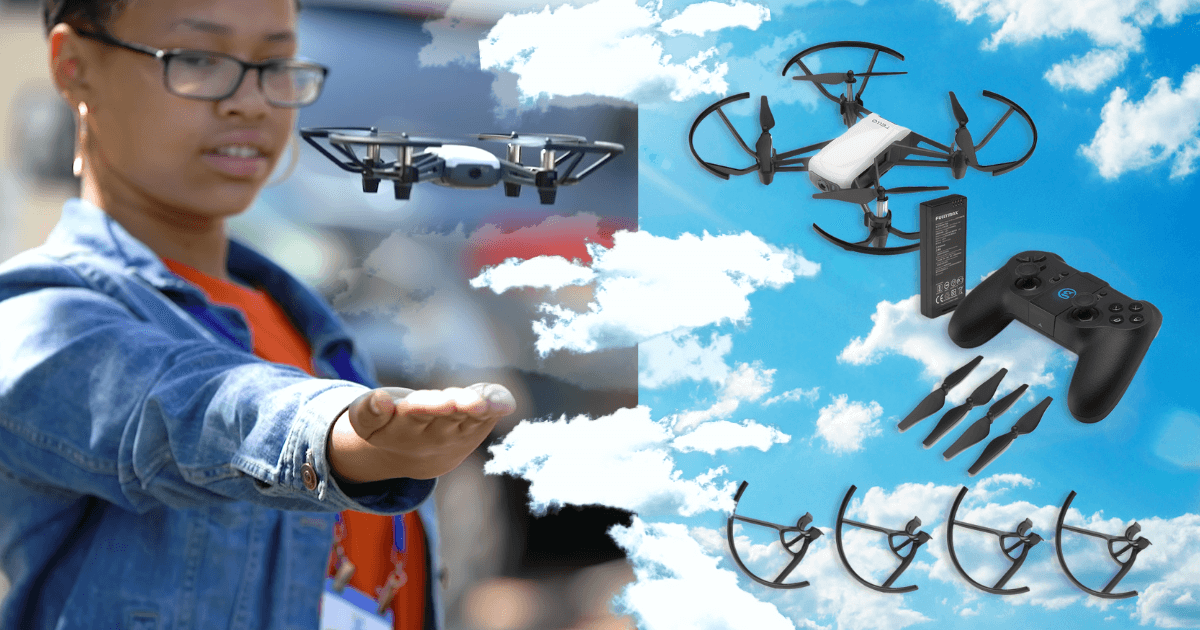When it comes to drones in education, there are more than a few solid options. Not many of them, however, are attached to one of the world's most well-known, respected, and reliable drone manufacturers. Born from the popular Tello drone, the Tello EDU from DJI has set itself apart in terms of educational aviators. At the top of the list of reasons why is the simple fact that it's programmable. Not only are students throughout middle school and high school able to easily fly the Tello EDU drone, they can program its entire flight path, too. And, as you may guess, this adds a whole lot of excitement and opportunity to STEAM learning.
Not only is the Tello EDU programmable, it's extremely lightweight, compact, versatile, and easy to create STEAM lessons around. It's equipped with many of the same technological advances found in other DJI drones but truly designed for simplistic integration in the classroom. As for its most important feature, students can program the Tello EDU in one of three languages. The simplest option is Scratch, followed by Swift, and then Python for more advanced programmers. Plus, they're also able to shoot phots, record videos, and program swarms of drones to fly together thanks to built-in AI functions and electronic image stabilization technology.
With the Tello EDU, students also get a bit of a chance to be engineers as well as programmers. The drone's propellor sets attach to its body and they're easy for students to snap on. From there, they can try beginner or advanced programming based on their age and comfort levels. For beginners, they can program the drone using block coding and easily drag and drop blocks into their programs. Advanced options include text-based coding in Python as we mentioned as well as the option to include the mission pads and write programs to get the drone to recognize and fly towards them. For larger classes, we also have the Tello EDU classroom kits as well as accessories that include extra propellors, an extra battery, propellor guards, and a multi battery charging hub.
DJI Tello EDU Drone:
The single Tello EDU drone is perfect for educators if they just want 1-4 units to use in the classroom. It's ideal to pair it with the Tello EDU app, which students can use to control the drone in a variety of modes. These include using the in-app joystick, bounce mode, or programming it with block or text coding. The single unit comes with one Tello EDU drone, one battery, on micro USB cable, eight propellors, four propellor guards, four mission pads, and one propellor removal tool. Whether they're new to drones and coding or have experience, there are tons of STEM connections with the Tello EDU.
Tello EDU Classroom Kits:
As for the classroom kits, there are three options: the Small Classroom Kit, Medium Classroom Kit, and Large Classroom Kit. Each are largely the same with the major differences being in the amounts of the components they come with. The Small Classroom Kit, for example, is ideal for anywhere from 5-15 students. It comes with five drones, five batteries, five cables, 40 propellors, 20 propellor guards, 20 mission pads, and five propellor removal tools. It also includes an additional five charging hubs, 10 batteries, 40 propellors, and 40 propellor guards.
The Medium Classroom Kit comes with 10 drones, 10 batteries, 10 cables, 80 propellors, 40 propellor guards, 40 mission pads, and 10 removal tools plus 10 extra charging hubs, 20 extra batteries, 80 extra propellors, and 80 extra propellor guards. Finally, the Large Classroom Kit follows the same pattern and includes 20 drones, 20 batteries, 20 cables, 160 propellors, 80 propellor guards, 80 mission pads, 20 removal tools, and 20 extra charging hubs, 40 extra batteries, 160 extra propellors, and 160 extra propellor guards.

Flight Accessories:
Finally, we have the Tello EDU accessories, which we've made mention of already. If you're opting to go with any of the classroom packs, you may not need too many more extras since they include so many but, if you're just getting a few single units, they could be valuable. Starting with the battery, this ensures students can use their drones for longer periods of time without stopping for recharging. They take 1.5 hours to charge and each extra battery adds about 13 minutes to the Tello EDU's flight time. Also, the charging hub allows students to charge three batteries at once. All they have to do is pair it with a standard electronics charger and they're good to go.
Next, we have the extra propellors, which serve as quick and easy replacements should any initial propellors get damaged. As such, it's always best to fly the Tello EDU indoors or in completely windless conditions but, if they ever do get damaged, students should be able to quickly swap in some fresh ones. The packs come with a set of four easily attachable and removable propellors. Finally, the propellor guards are lightweight plastic pieces that shield the propellors from any potential impacts. They're also easy to attach and remove and reduce the risk of damage to the propellors and the drone itself. Since they are lightweight, however, it's also best to use them in controlled environments.
Students can do a whole lot with the Tello EDU drone and the optional accessories. From engineering and coding to photography and videography, they truly help unlock innovative 21st century learning opportunities. Also, if you're new to using drones in education, the DroneBlocks professional development content helps educators learn about the features and capabilities of the Tello EDU as well as how to integrate it in STEAM learning. You can find the Tello EDU packs on our store (and below) and feel free to reach out with any questions. Follow us on Twitter and Instagram for more.







